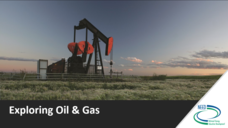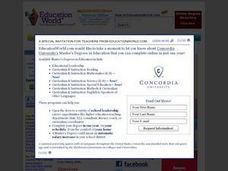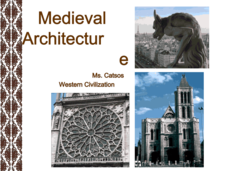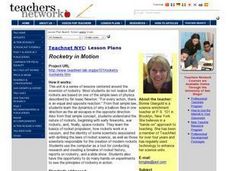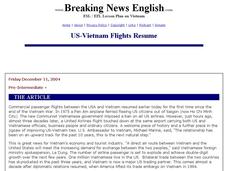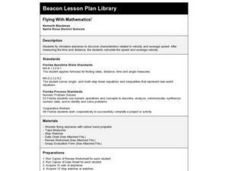Education World
Every Day Edit - First Hot-Air Balloon
Daily practice develops skills! Use this half-sheet to help learners correct grammatical errors in capitalization, punctuation, spelling, and grammar. Today's topic is a hot-air balloon flight.
American Museum of Natural History
Talk to a Titanosaur
Learn all about the Titanosaur with an engaging website that delves deep into the large reptile's physical traits, family history, discovery, and fossil reconstruction.
National Energy Education Development Project
Exploring Oil and Gas
The United States consumes more oil than any other country, about 1.85 billion barrels (or 77 billion gallons) a day. Viewers learn about the history of fossil fuel exploration and how they are formed in an informative presentation. They...
Curated OER
Note Taking By Crayon
Skim a brief biography of Amelia Earhart with your class, and then assign groups of researchers one of four topics listed: Amelia's family life, important airplane flights during Amelia's life, turning points in Amelia's life, and...
Curated OER
Medieval Architecture
While this resource is about architecture, it isn't about art. It demonstrates the differences between Romanesque and Gothic architecture to show changes in the socio-political spectrum of the time. Images and good discussion questions...
University of Colorado
Strange New Planet
The first remote sensors were people in hot air balloons taking photographs of Earth to make maps. Expose middle school learners to space exploration with the use of remote sensing. Groups explore and make observations of a new...
Curated OER
How Things Fly
Learners, by drawing on their own experiences, discuss and examine the basic physics of flight. They participate in a variety of activities regarding flight.
Curated OER
Wright Brothers Centennial: North Carolina, Creation and Development of the State
Eighth graders examine technological advances and how they influenced the quality of life in North Carolina. Using maps, they locate the city of Kitty Hawk and discuss why it was chosen for the first flight. They read primary source...
Curated OER
Mankind's Fascination With Flight
Students discuss, examine and appreciate the science and inspiration of flight. They study the terms and mechanics of powered flight and demonstrate that the heating of air makes it lighter and therefore rise. They discuss and...
Curated OER
Come Fly With Me...Aviation
Students conduct internet research on aviation and pioneer aviators. They create an alphabet book r with flight related terms, write a short biography of a pioneer aviator and take part in a paper plane flying contest.
Curated OER
An Uplifting Experience
Students examine the forces that affect the flight of airplanes through the use of paper airplanes. They conduct Internet research, conduct experiments demonstrating Bernoulli's Principle, and design and construct a paper airplane.
Curated OER
Rocketry in Motion
Students investigate why a balloon flies in one direction as air escapes in the opposite direction, which helps them understand the nature of rockets and fireworks. Individually and in teams, students conduct research to create a...
Curated OER
Art to Zoo: Kiting Up The Sky: The Vehicles of Understanding
Students gain perspective on the importance of kites by reading about and discussing how kites have been used throughout history. In this kite exploration lesson, students follow instructions to construct a kite to assist them in...
Curated OER
Kites: Patang - The Indian Fighter Kite
Students investigate the history of fighter kites and build their own. In this aeronautics lesson, students discover how other countries utilize fighter kites and where they originated. Students create their own fighter kites...
Curated OER
Focus Questions: Amelia Earhart
In this history worksheet, students do research and find information about Amelia Earhart. Students answer 18 questions about her biographical overview, the world flight and disappearance and the search. No information is given on the...
Curated OER
Basic Animal Behavior in Domesticated Animals
Students investigate animal behavior, examining the nervous system and the physiology of the brain and the fight or flight response. They simulate animal behaviors and discuss the difference between an instinct and a behavior.
Curated OER
Go Fly a Kite!
Students study kites. In this social studies instructional activity, students discover the history of kites and what kites are made of. Students create their own kites to fly.
Curated OER
Archaeology For Kids Quiz 83
In this archaeology for kids quiz 83 activity, students interactively answer 12 multiple choice questions about the history of money, as part of an online magazine.
Curated OER
George Herbert Walker Bush
In this American history learning exercise, students read a biography about George Herbert Walker Bush and complete 8 multiple choice questions.
Curated OER
Worksheet 4. Predictions
In this predictions worksheet, students read 6 predictions that were made in history and identify each of them as true or false. Idioms and words are defined at the bottom of the sheet.
Curated OER
Breaking News English: US-Vietnam Flights Resume
In this English worksheet, students read US-Vietnam Flights Resume," and then respond to 47 fill in the blank, 7 short answer, 20 matching, and 8 true or false questions about the selection.
Curated OER
Celebrating 100 Years of Flight
Students explore the history, science, and journey through flight. They use the Internet to access information in order to participate in active writing assignments. They conduct other activities and build their own virtual plane.
Curated OER
Language Arts: Women in History
Students read excerpts from Amelia Earhart's autobiography, "The Fun if It," and identify her character traits. To aid visualization of her transatlantic flight, they search books and the Internet for photos related to Earhart's flights....
Curated OER
Flying With Mathematics!
Third graders fly miniature airplanes to discover characteristics related to velocity and average speed. After measuring the time and distance of their flights, 3rd graders calculate the average velocity of their planes.




